These top 20 special yoga exercises to improve infertility, or sexual disease, or erectile dysfunction, along with doing daily pranayama, practicing the especially 1 to 5 minutes each, will definitely benefit you.
Yoga for fertility yoga is a combination of yoga postures and pranayama and meditation (de-stressing techniques) used to correct and balance the body and mind.
Yoga postures and meditation for fertility are natural ways to aid in conception. Also, these fertility yoga postures and pranayama optimize the psychological mindset of the individual by reducing the stress levels, which play an important role in case of infertility or sexual disease or erectile dysfunction.
How it helps to improve infertility or sexual disease
Special yoga postures and pranayama increase the blood supply to the reproductive organs such as ovaries, uterus, and testes. As it gets more nutrients, the vitality of these organs is maximized.
Yoga for fertility improves hormone levels, stimulates ovulation and increases sperm count.
It helps those who are overweight or have flabby muscles to tone muscles, increase flexibility, and these exercises have been shown to slow the aging process of eggs and sperm.
Yoga practitioners also improve their diet and lifestyle, which greatly increases the chances of conception and regularizes menstruation.
Yoga improves sleep patterns, pregnancy rates improve significantly in women undergoing the rigors of infertility treatment.
Practicing meditation and relaxation helps reduce stress levels, helps enhance sexual performance, enhances emotional connection and intimacy, and helps sperm penetrate the uterus.
The Top 20 Special Yoga Asana to Improve Infertility or Sexual Disease
Top 20 Special Yoga Asanas to Improve Infertility, or Sexual Disease, or Erectile Dysfunction:
- Brahmacharyasana
- Janu Shirasasana (One-legged forward bend)
- Paschimottanasana (Seated forward bend)
- Kumbhakasana (Plank pose)
- Hastapadasana (Standing forward bend)
- Virabhadrasana II (Warrior II Pose)
- Utkata Konasana (Goddess Pose)
- Sarvangasana (Shoulderstand)
- Puppy Pose (Uttana Shishosan)
- Halasana
- Naukasana (Boat Pose)
- Bridge Pose (Setu Bandha Sarvangasana)
- Bow Pose (Dhanurasana)
- Headstand
- Baddha Konasana (Butterfly pose)
- Uttanapadasana (Raised leg pose)
- Viparita Karani (Legs up the wall pose)
- Supta Baddha Konasana (Reclining Bound Angle Pose)
- External Retention (Bahya pranayama)
- Shavasana (Corpse pose)
1. Brahmacharyasana
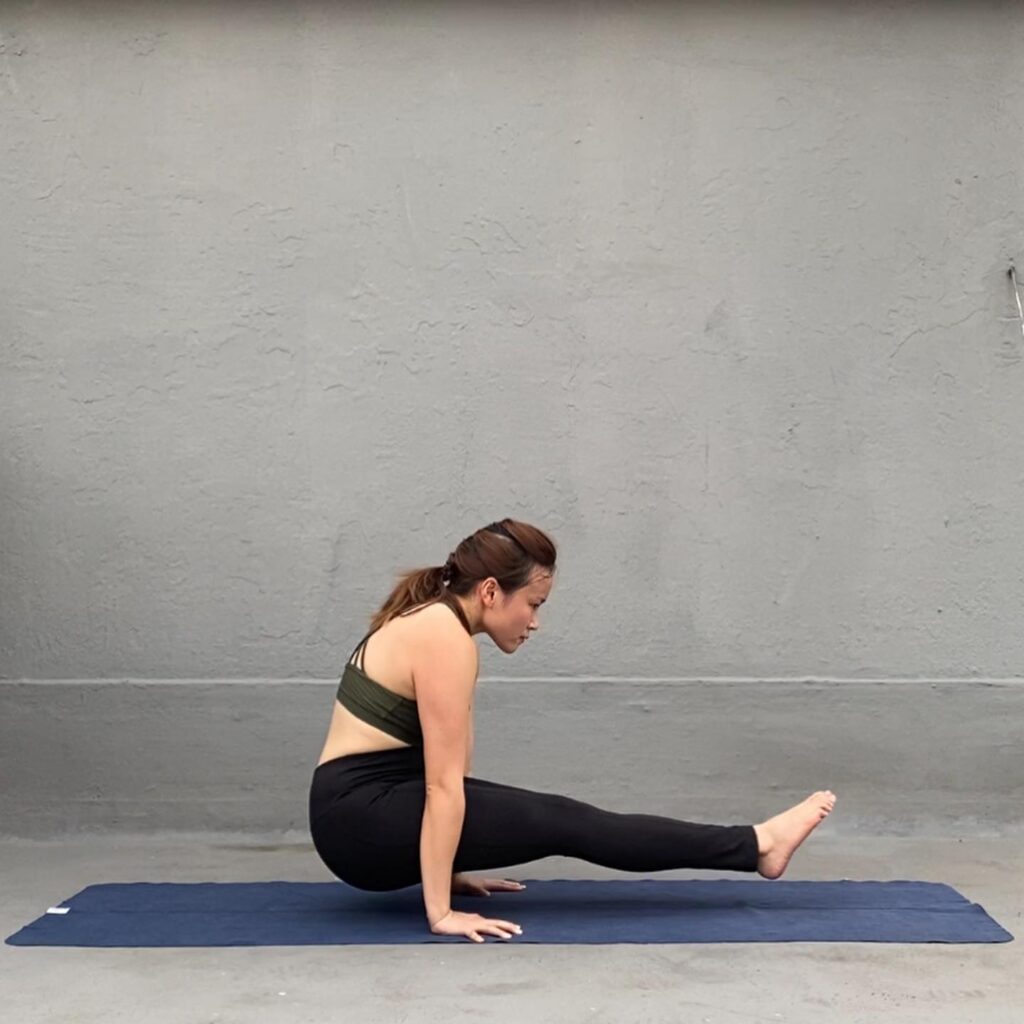
How to:
- Sitting in Vajrasana, turn the claws outward with the help of hands.
- The heels are placed near both the buttocks on the inside and the claws are on the outside.
- Both knees should be joined, keep hands straight on knees.
- Waist straight and breathing speed should be normal.
- Do as much power from 5 minutes to half an hour.
Benefits
- This posture is the same name as the name for Brahmacharyasana (celibacy/self-restraint).
- It is beneficial in all types of metal diseases, dream diseases, spleen, diabetes, etc.
- It benefits in sexual disease because while doing this pose, it squeezes the sexual organ, which helps in the production of stress hormones in that area which helps in stimulating the sexual organ.
- This pose also improves blood flow to the sexual organ, which will help in enhancing the function of sexual performance.
- The pose helps in improving the strength of the hips, calf and thigh muscles, and all these body parts are very useful for optimum sexual performance.
Note: Avoid this pose if you suffer from severe back, neck, or head injuries, high or low blood pressure, heart problems, weight issues, hernias. Avoid it during the menstrual cycle and also during pregnancy.
2. Janu Shirasasana (One-legged forward bend)
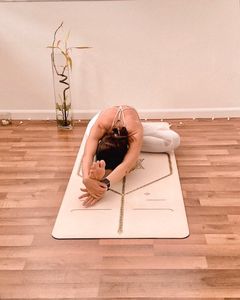
How to:
- Start sitting in Staff Pose or Dandasana (sit with your legs stretched out in front of you).
- Bend the right knee and place your right foot against your left thigh, letting the knee rest on the bottom.
- Inhale, and flex your left foot, press the top of your thigh down, lengthen your spine and raise the arms to either side of the head.
- Slightly rotate the upper body so that you are facing the left leg and then as you exhale, bend forward from your hips.
- Keep your shoulders relaxed, chest open, and spine long.
- Put the hands down, frame the left leg, or clasp the ankle or foot.
- Stay in this position for 60 to 120 seconds, and then inhale, come out of the posture.
Benefits
It calms your mind, stimulates digestion. Stretches your hips, back of the body, waist and more blood reaches the lower organs. Removes menstrual problems, stimulates kidney and liver.
Note: If the rear raised knee feels uncomfortable, bend it slightly and place a blanket underneath. If there is pain in the lower back, leave this posture.
3. Paschimottanasana (Seated forward bend)
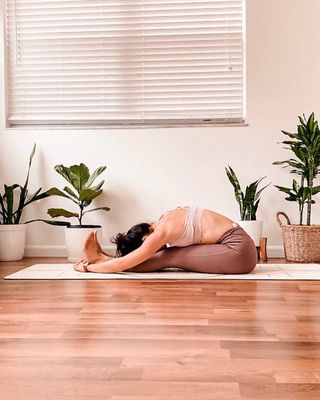
How to:
- Begin by sitting on the floor in Dandasana (Staff Pose) with the legs extended straight in front of the body or on the thighs.
- Raise the hands above your head.
- Inhale while keeping the spine up and straight.
- As you exhale, slowly bend toward the toes as far as the body allows.
- Stay in this position for a few seconds and breathe normally and slowly.
- To get out of this position, lift your head up and slowly come to the starting position by spreading the legs.
- As a starting position, this Asana can also be done lying on the floor with the back of the head extended. After rising from this position, the rest of the steps of Paschimottanasana can be repeated.
- After the completion of Paschimottanasana, it is recommended to do any Asana that involves bending backwards as a counter stretch.
Benefits
- It massages and tones the abdominal and pelvic organs, making it a simple yet effective yoga pose to burn unwanted fat and aid in weight loss.
- Paschimottanasana helps to calm the brain, thereby relieving stress, mild depression, reduce anxiety and fatigue.
- Improves blood circulation in your back and tones the shoulders and stretches the lower back, hamstrings, and hips.
- The pose help stimulate the liver, kidneys, ovaries, and uterus. Helps with the symptoms of insomnia and promotes good sleep.
- Helpful in sexual diseases, regular practice of the asana leads to direct massage of the pelvic region and thus is helpful for various types of sexual disorders like menopause, menstrual discomfort etc.
Note: People suffering from back injury should avoid doing this asana, and individuals should not bend beyond a certain limit otherwise it can cause severe back pain. Also, if someone is suffering from headache, migraine and diarrhea, then this yogasana or mudra should not be practiced.
4. Kumbhakasana (Plank pose)
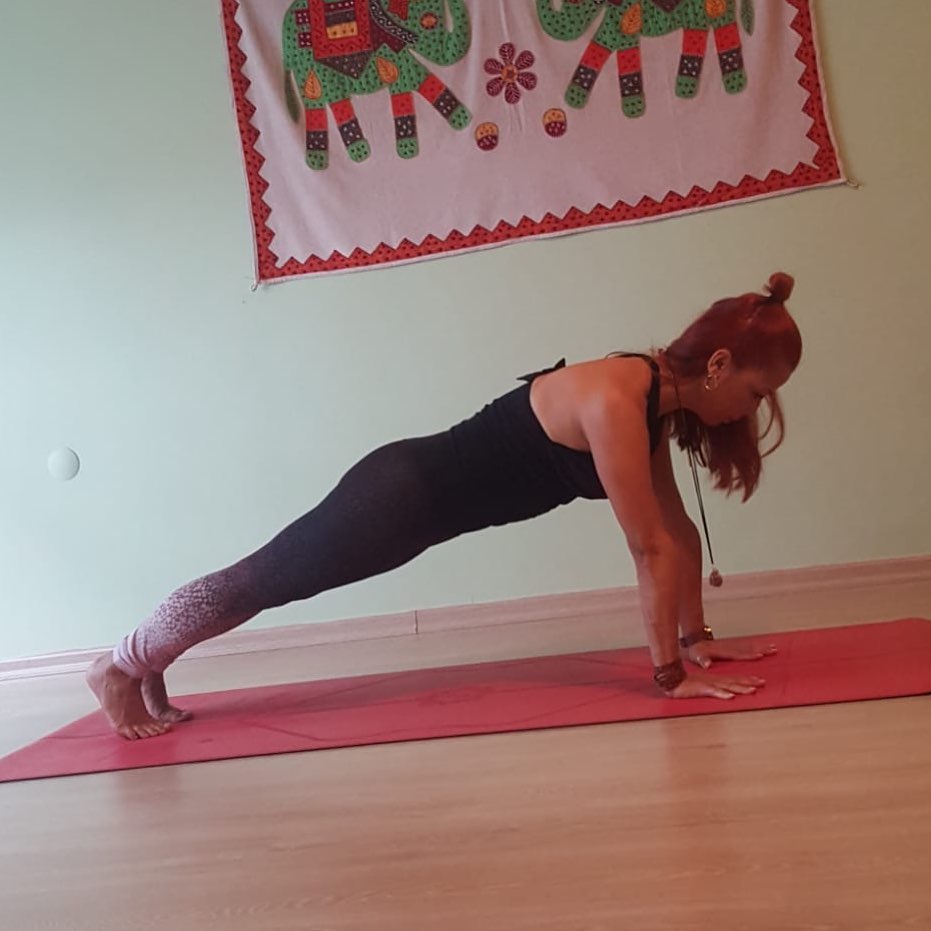
How to:
- From Balasana (Child Pose), extend your arms forward, come on hands and knees, toes down, keeping your feet together. Some practitioners may need to extend their hands half a hand.
- Inhale, and as you exhale, bring your body forward, bringing your shoulders directly over your wrists as the legs straighten and form a straight line from your heels to shoulders.
- Hold and breathe, taking care that your wrists are directly under your shoulders, and being careful not to fall between your shoulder blades or hyperextended elbows.
- To release, come onto hands and knees as you exhale, looking forward, and slowly push back into Balasana (Child’s Pose).
Benefits
The pose calms the mind and reduces the risk of anxiety and depression. Best exercise for weight loss, improves core muscles, strengthens abdominal muscles, keeps the digestive system healthy.
Note: Individuals suffering from wrist pain or carpal tunnel syndrome should avoid this pose.
5. Hastapadasana (Standing forward bend)
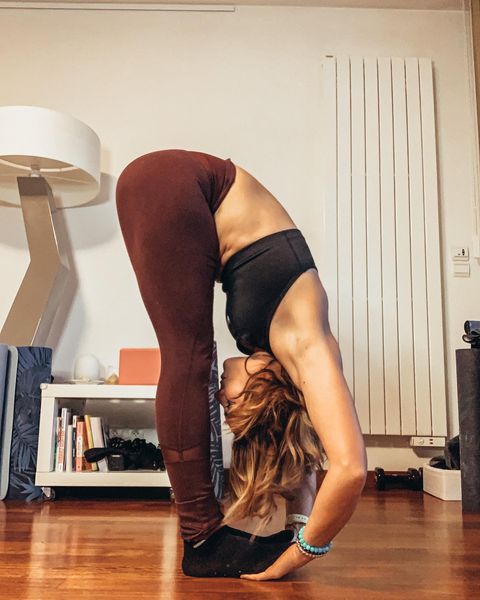
How to:
- Stand straight with your erect spine. Your both legs should touch each other.
- Inhale, and bring your both hand above the head, your hands should be straight.
- Exhale, and bend forward from your waist and try to touch the feet with your both hands.
- Do not bend your knees, and your head should be in contact with your knees.
- Hold this position for 30 to 60 seconds and breathe normally.
- Now, while inhaling, come back to starting position and repeat this process for the few more times.
Benefits
Effective in increasing height. Reduce belly fat and give a flat stomach, strengthen back muscles and stimulate the nervous system. Beneficial for reducing menstrual problems and very useful during pregnancy.
Note: People suffering from high blood pressure, spine issue, hernia, ulcer, cervical issue or any type of back pain should not practice Hastapadasana.
6. Virabhadrasana II (Warrior II Pose)
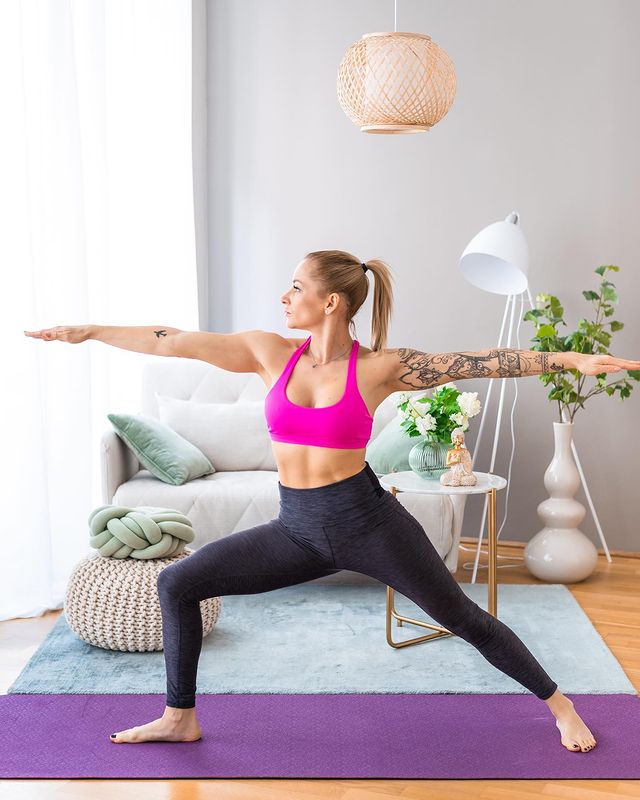
How to:
- Stand in mountain pose (Tadasana). While exhaling, keep the feet 4 feet (1.22 m) apart from each other.
- Now bend down slightly and bend the knee of the front leg at 90 degrees. Keep the other leg straight; parallel to the floor.
- Then bring the arms wide, parallel to the floor. The palms should be facing down.
- Place the space between your right hip and thigh-bone.
- Stay in this pose for 10 to 30 seconds, then repeat on the other side.
Benefits
Strengthens and stretches the legs, ankles, and feet. Builds stamina and concentration, stimulates the abdominal organs. Helps relieve back pain, especially during the second trimester, and improves circulation and respiration. Therapeutic for flat fleet, sciatica, osteoporosis, carpal tunnel, and improve infertility.
Note: Individuals with neck pain should avoid it, also avoid if you have had knee, shoulder, hip surgery or are suffering from spine disease.
7. Utkata Konasana (Goddess Pose)
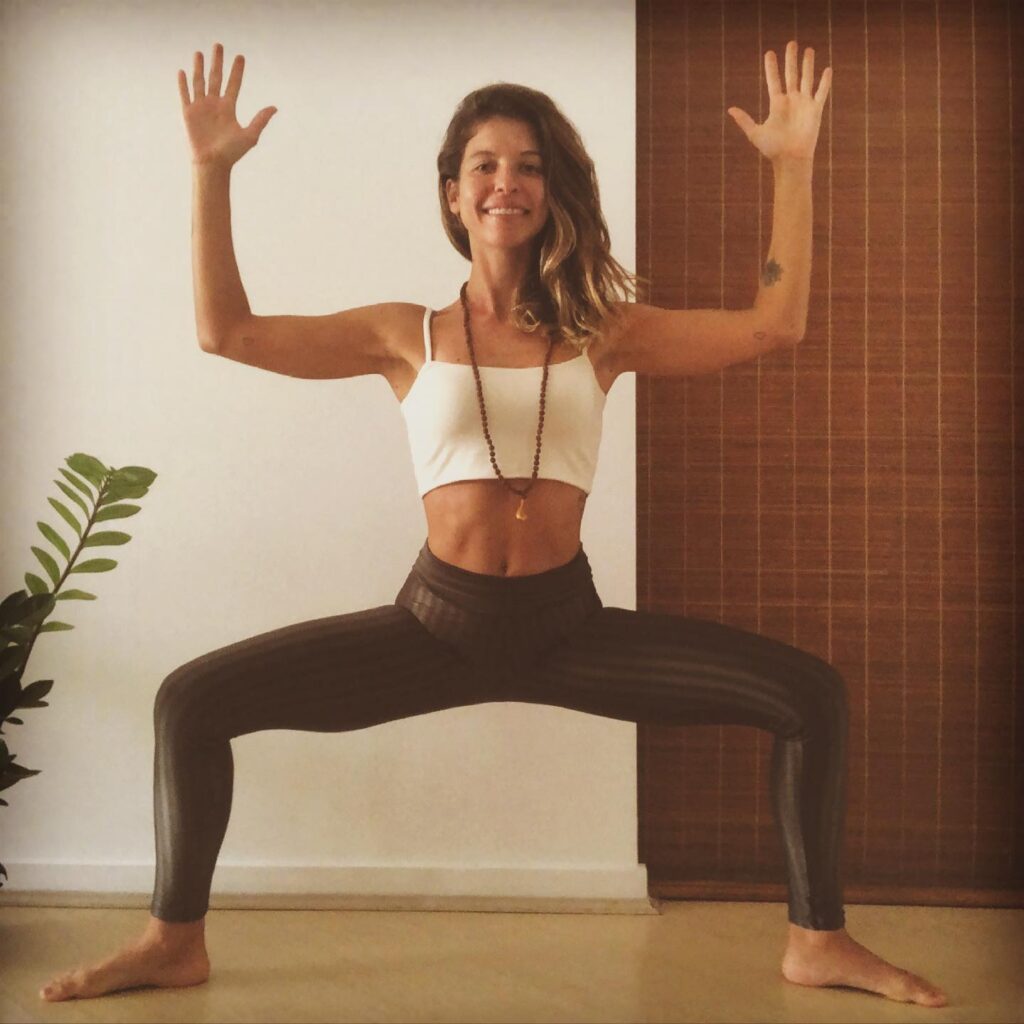
How to:
- Start in a wide standing stance, turn the toes and heels inward, so that the feet are pointed at about a 45-degree angle.
- Bend the knees in the same direction as the toes, and lower the hips toward knee height.
- Bring the arms to shoulder height and bend the elbows so that the fingers are facing the sky. Spread the fingers wide and activate the muscles across the back.
- Engage core muscles and pull the tailbone toward the floor. Keep the spine long.
- Stay here for 30 to 60 seconds, then release.
Benefits
The pose stimulates the urogenital, respiratory and cardiovascular systems. It helps women to feel confident, sexy, beautiful and strong. It is the good pose of childbirth and feminine power, especially for pregnant women. The pose also stimulates the reproductive organs by increasing the flow of prana energy in the area, thereby improving fertility. It also relieves menstrual pain and cramps.
Note: Avoid this pose if you have recently injured your legs, hips, or shoulders.
8. Sarvangasana (Shoulderstand)
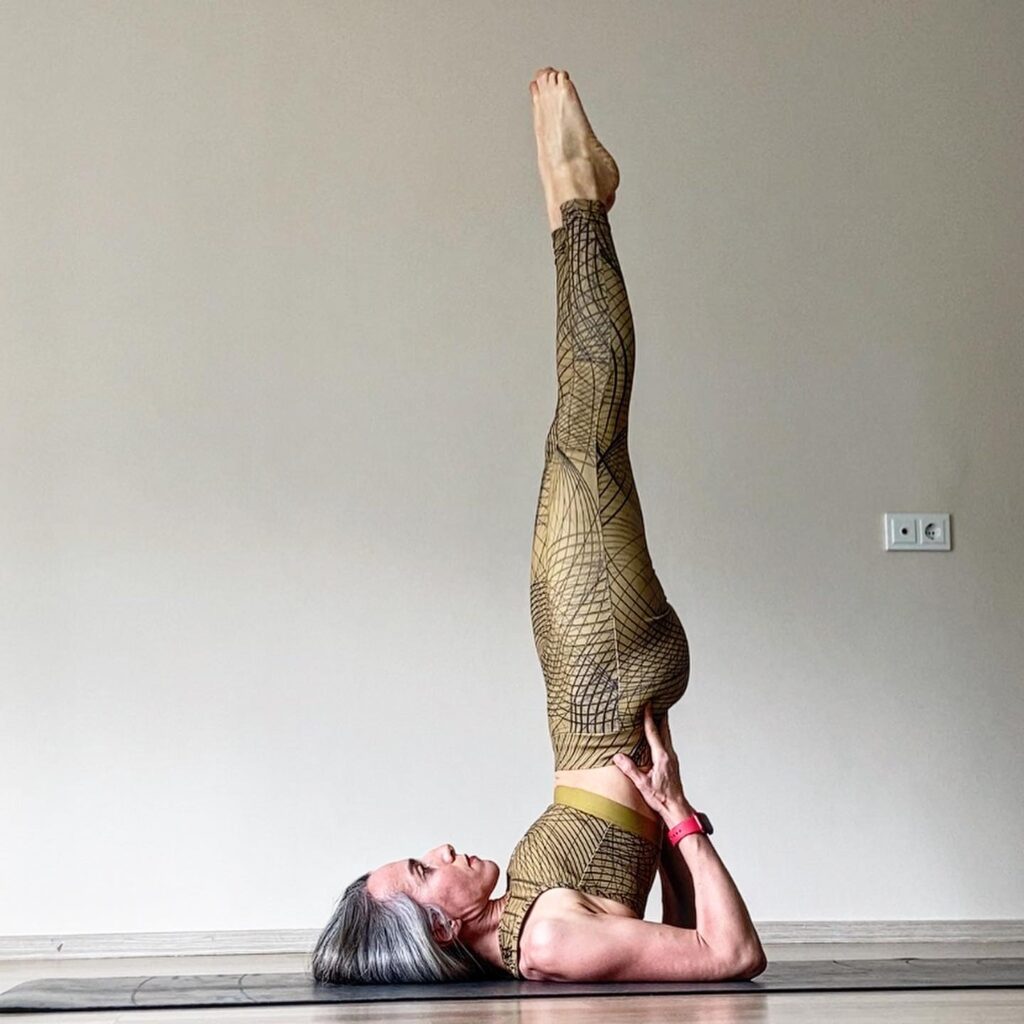
How to:
- Lie flat on your back. With the feet together, keep the palms facing the ground on both sides with the arms side by side.
- After inhaling, lift the feet slowly to 30 degrees, then to 60 degrees and finally to 90 degrees.
- You can take help with hands while lifting the legs.
- If it is not straight at 90 degrees, then by putting the feet at 120 degrees and raising the hands, put it behind the waist.
- The elbows rest on the ground and keep the legs together straight.
- Claws upward with trunk and eyes closed, or keep a sight on the toes.
- Starting from 2 minutes, this Asana can be done slowly for half an hour.
- While coming back, tilt it slightly backward, keeping the legs straight.
- Remove both hands from the waist and straighten them on the ground.
- Now, while pressing the ground with the palms, slowly straighten the back and then the feet on the ground in the same order from which you were raised.
- The longer the Sarvangasana is done, rest in Shavasana for about the same time.
- The competitive or complementary Asana of this Asana is Matsyasana.
- Therefore, doing Matsyasana before rest in Shavasana is more beneficial than this Asana.
Benefits
- All other benefits are similar to headstand. But this posture has the specialty that those for whom head-position is prohibited can also do it. This Asana has also been found useful for 2 to 3 stages of asthma; because shoulders are fixed in this posture. The weight of the abdominal organs, intestines, etc., by falling on the medial muscle and participating in breathing, improves the tone of the diaphragm.
- With this Asana, the thyroid and the pituitary gland are mainly active, it is particularly useful in increasing stature.
- The pose relief in case of constipation, dyspepsia, headache, dizziness, neurasthenia, functional disorders of your eye, ear, nose, and throat as well as general and sexual disease.
- As an inversion pose, the pose sends blood from your legs and pelvis back to your heart and lungs to be freshly oxygenated, which can increase energy. 1
- Research involving yoga practices, including Sarvangasana, has also been found to help reduce lower back pain. 2
Note: Avoid this pose if you have high blood pressure, heart disease, pregnancy, respiratory disorders, high myopia, glaucoma and retinal detachment.
9. Puppy Pose (Uttana Shishosan)
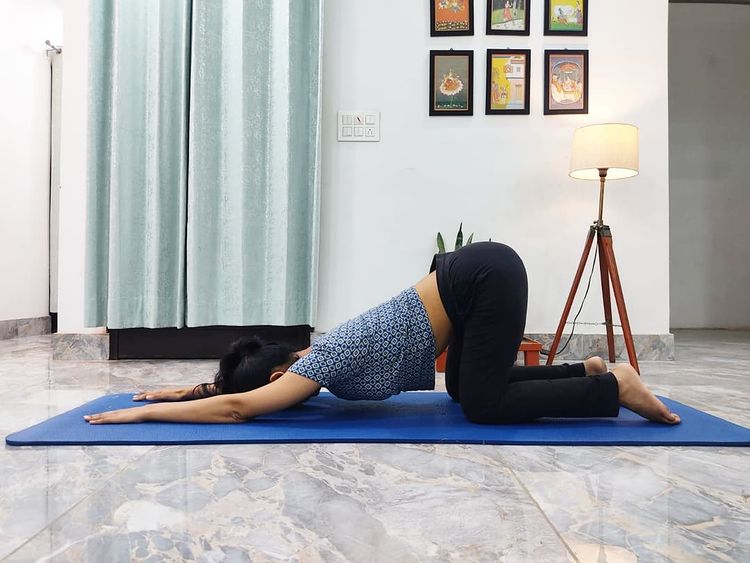
How to:
- Bring knees together from child’s pose or tabletop.
- Walk the fingers forward and bring the chest to the floor.
- Lift the hips up towards the ceiling, opening the chest and arching the back.
- Hold for 30 to 60 seconds before moving into another pose.
Benefits
The blood flows downwards towards the chest and shoulders, and this reverse flow of blood works well for the whole body. It also helps in making the body strong. The pose, introspection promotes self-love, helps reduces anxiety and helps reduce stress, which are commonly linked with infertility.
Note: You can skip this pose if your arms and shoulders are tight. Also, if you are suffering from severe lower back pain, it is recommending that you do not practice this pose as it can aggravate the pain and lead to stiffening of the back. Furthermore, avoid in case of knee injury.
10. Hallasana
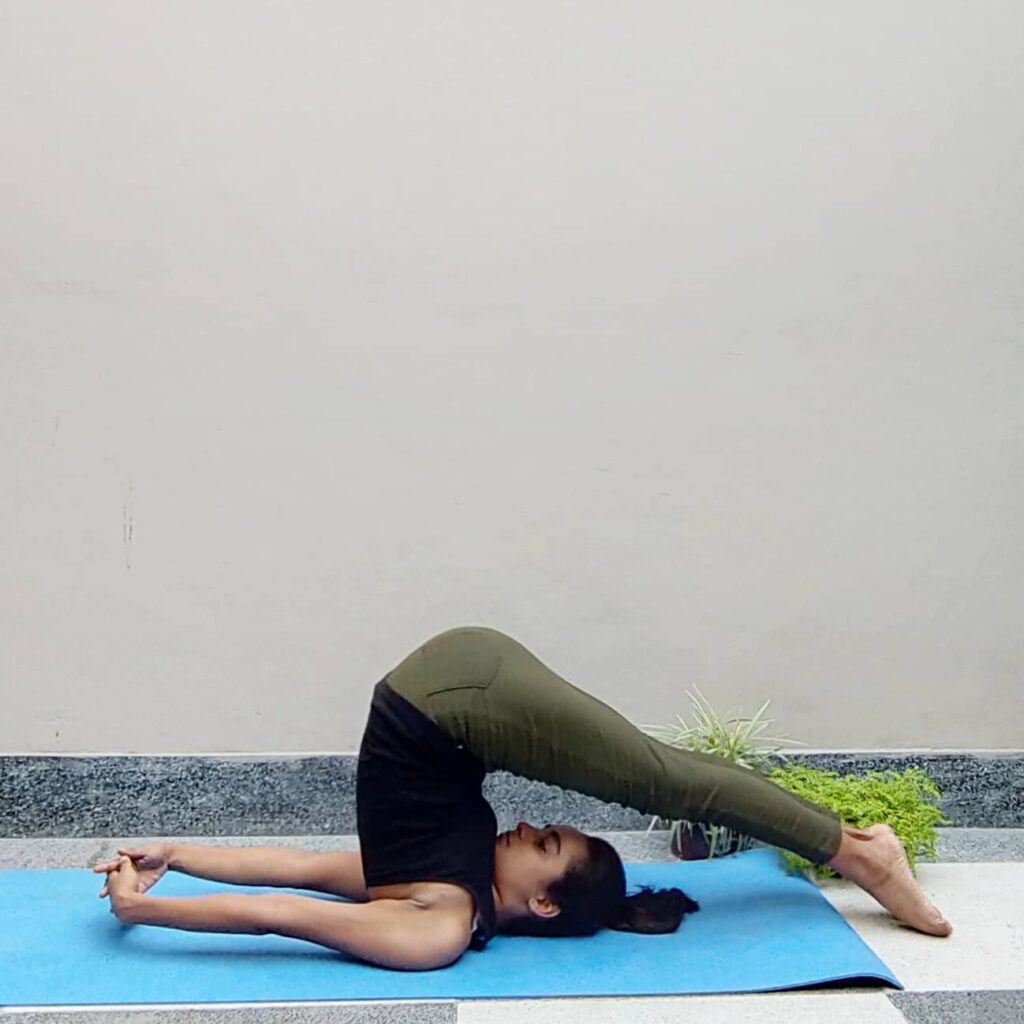
How to:
- Lie on your back, now slowly lift the legs while inhaling.
- After lifting first 30 degrees, then 60 degrees, then 10 degrees, move the legs towards the back of the head while also raising the back while exhaling.
- Place the feet behind the head on the ground. Breathing speed will be normal. Initially, the hands can be placed behind the waist for convenience.
- Keep your hands on the ground in full condition. Stay 30 seconds in this situation.
- The way you came up while coming back, while pressing the land with the palms, keep the feet straight on the ground with the knees straight.
Benefits
- By making the spinal cord healthy and flexible, the muscles of the backbone also enlarge and make the disease.
- Thyroid removes obesity, dwarfness and weakness etc. by tightening the gland.
- Indigestion, by tightening the gland, removes obesity, dwarfness and weakness.
- Activates the pancreas and removes diabetes.
- This asana is also useful in women with dysmenorrhea etc.
Note: This posture is prohibited in the enlarged spleen and liver. Patients with high blood pressure, cervical spinal cord, etc. should not do this Asana. Do not do this Asana even if you have TV etc. disorders in slip-disk and spinal cord.
11. Naukasana (Boat Pose)
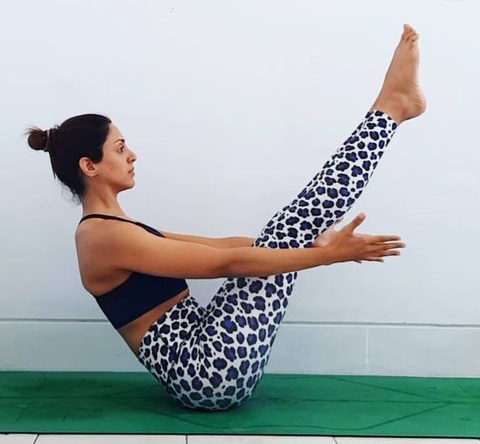
How to:
- Lie on the back with your legs extended and hands next to the body.
- Take a deep breath and as you exhale, lift the chest and legs off the floor, extending the arms towards the feet.
- The eyes, fingers, and toes should be in a straight line.
- Feel the tension in the navel area as the abdominal muscles contract.
- Keep breathing deeply and smoothly while maintaining the posture.
- As you exhale, slowly return to the floor and relax.
Benefits
The pose improves the health of all the abdominal organs, especially the liver, pancreas, and kidneys. Improves blood circulation and is good for the prostate and thyroid glands. Most importantly, this pose acts as a distress tool, keeping the mind free and peaceful.
Note: Asthma, low blood pressure, severe headache, migraine, and heart patients should not practice this pose. People suffering from chronic diseases or spinal disorders, women during pregnancy and also during the first two days of the menstrual cycle should avoid practicing this yoga pose.
12. Bridge Pose (Setu Bandha Sarvangasana)
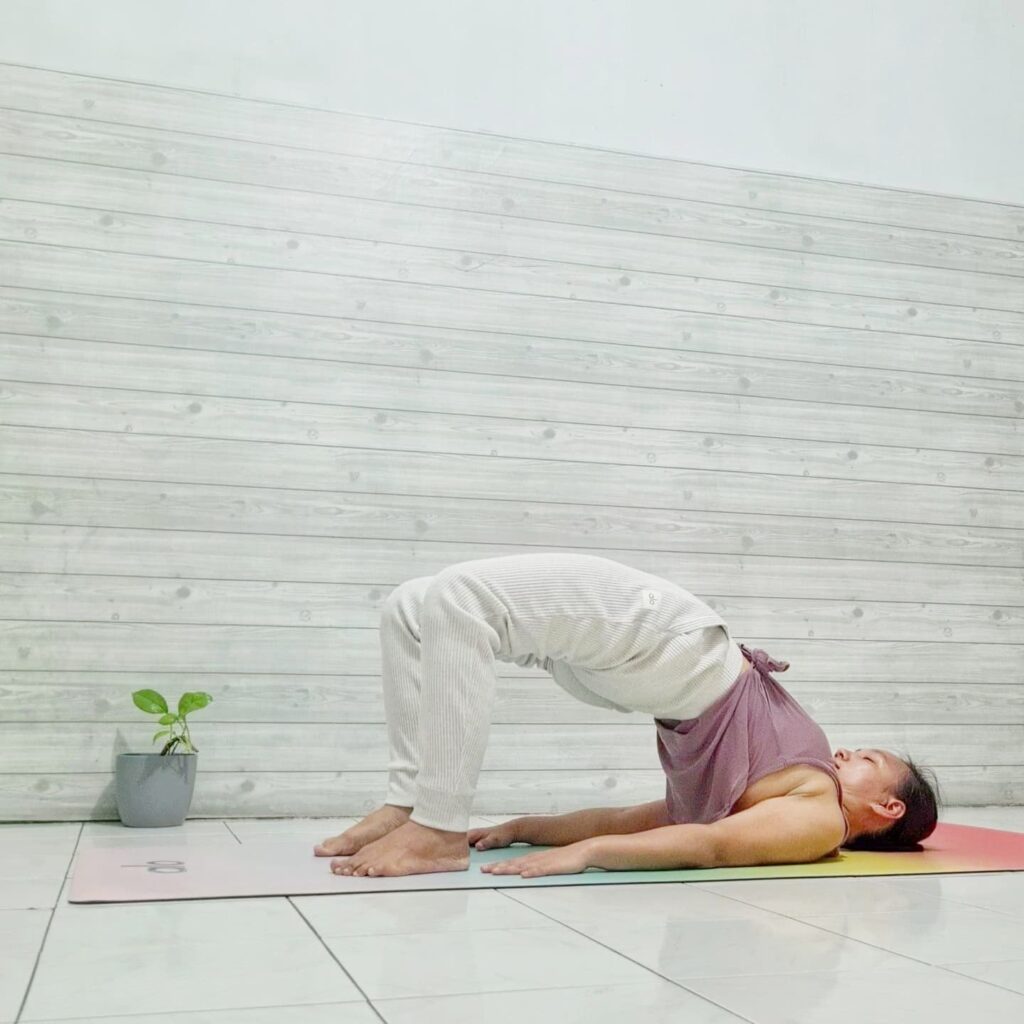
How to:
- Lie on your back with both knees bent and feet hip-width apart on the floor. Keeping the palms facing down, slide the arms along the body. The fingers should touch the ankles lightly.
- Press feet into the floor, inhale and lift hips, lifting spine off the floor. Lightly squeeze your knees together to keep your knees hip-width apart.
- Press into the arms and shoulders to lift your chest. Engage the legs, buttocks, and core bandha to lift the hips higher.
- Breathe in and hold for 4-8 breaths.
- To release: Exhale and slowly lower spine back to floor.
Benefits
Opens up the lungs and reduces thyroid problems. Helps relieve symptoms of menopause and menstrual pain, calms the brain, reduces anxiety, stress, and depression, which are also linked with improve infertility.
Note: Avoid this pose if you have recently suffered a knee, shoulder or back injury.
13. Bow Pose (Dhanurasana)
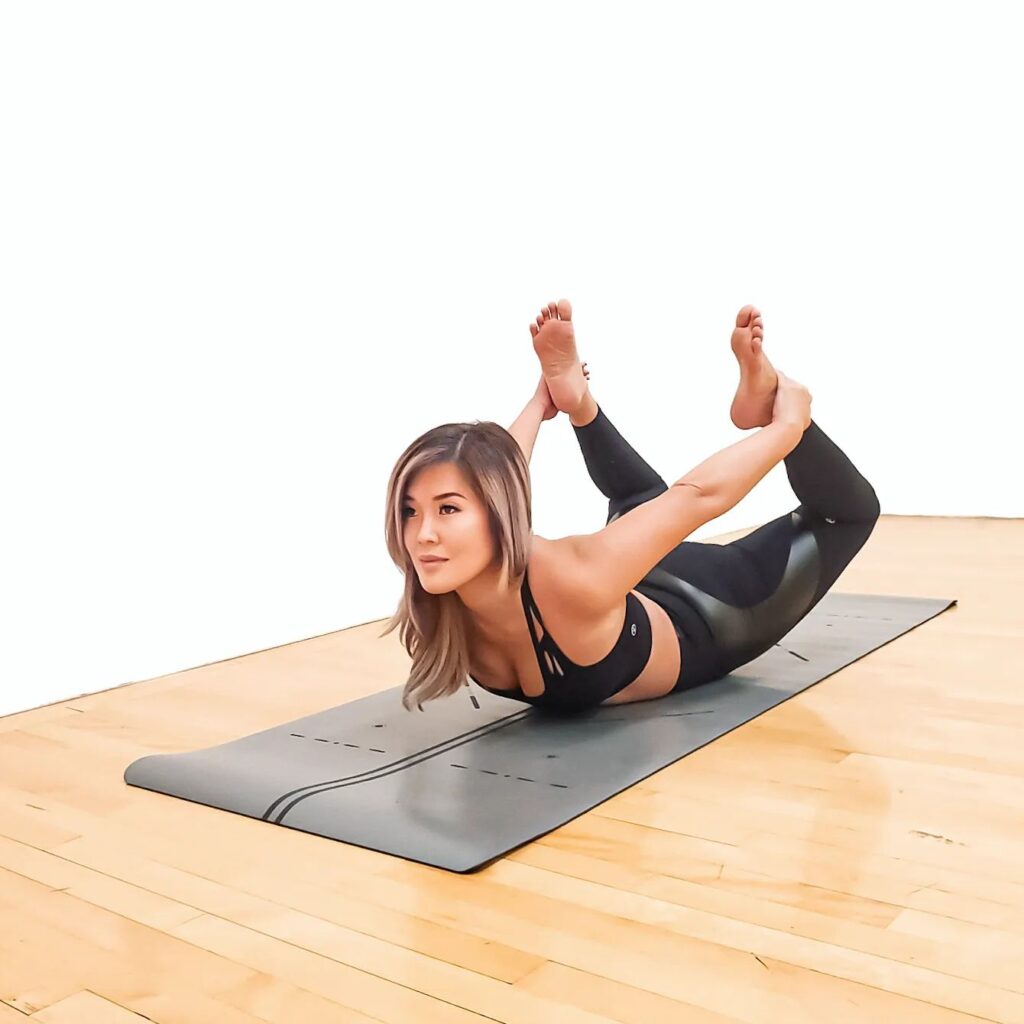
How to:
- Lie on the stomach, with your hands at the sides, palms facing up.
- Bend the knees and clasp the ankles with the hands.
- Squeeze the pubic bone down, pull the lower abdomen in and up.
- Inhale, press the ankles into the hands, lift the chest and thighs.
- Slide the shoulder blades down and toward each other to open up the chest.
- Hold for a few breaths, breathe into the chest and ribs.
- As you exhale, release the ankles, and lie down on the stomach gently for a few breaths.
Benefits
The pose helps people with kidney (kidney) disorders like kidney stones, glomerulonephritis, polycystic kidney, urinary tract infection (UTI), etc. It cures dyspepsia (obesity), rheumatism and gastrointestinal problems. The spinal column is elongated, which improves blood circulation in the spinal nerves. Stimulates your liver and improves the function of all the surrounding organs. It treats gastritis (obesity), arthritis and digestive issues. It also enhances the function of pancreas and is good for diabetes.
Note: Avoid practicing if you have hernia, insomnia, neck injury, spondylitis, low back pain or back injury, migraine headache, stomach ulcer and recent abdominal surgery.
14. Headstand
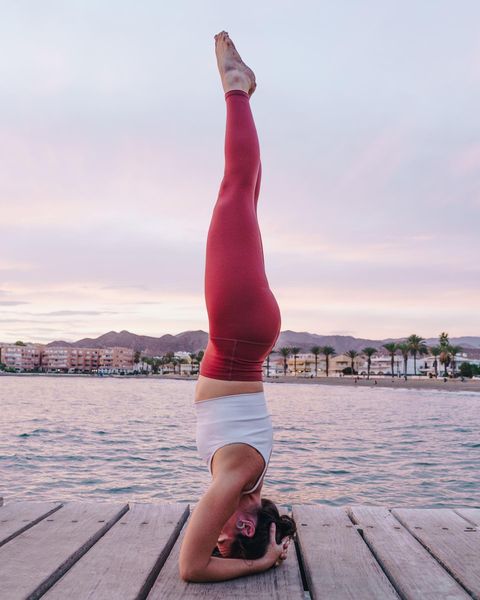
How to:
- Make a circular pad of dhoti or any long cloth.
- Put the fingers of both hands together and keep the hands on the ground till the elbow.
- Keep the pad between the hands.
- The head of the head should be on the seat and the knees are on the ground.
- Now, with the weight of the body balanced on the cervix and elbows, straighten the legs parallel to the ground.
- Now raise one knee above the bend, after that lift the other knee up and keep it bent.
- Now try to raise the bent knees one by one respectively.
- Do not rush in the beginning. Slowly the legs will start to straighten.
- When the legs are straight, then join them together and keep leaning slightly forward, otherwise there is a fear of falling backwards.
- Eyes closed, breathing speed should be normal.
- The order in which the feet were raised should be brought back to the previous position.
- After Headstand suited to your nature, do the shavasana or bruise, so that the flow of blood that was going on towards the brain becomes normal.
- This posture can start from 15 seconds to half an hour.
- Practice more in someone’s connection.
- In normal state, doing 5 to 10 minutes is sufficient.
Benefits
- This posture is the king of all the Asana. With this, pure blood gets to the brain, which provides health to the eyes, ears, nose, etc.
- It activates the brain by healing the pituitary and pineal glands. Develops vigor, alertness, relaxation, memory, intelligence, and perception power. 3
- The digestive system activates gastric, intestine and liver and illuminates gastritis.
- It also cures diseases like growth, enteritis, hysteria and testicles, hernia, constipation, varicose Vance etc.
- The thyroid gland removes both active chronic debility and obesity; Because of the irregularities in the action of thyroid, these diseases occur.
- The thyroid stabilizes celibacy by activating the gland. Nocturnal emission, urinary disorders, erectile dysfunction (impotence), perforation etc. destroy Metallic disease. Increases ooze (Light) and bright on the mouthpiece.
- Those who have untimely hair fall and are white, both these diseases are overcome by doing a Headstand (headstand).
Note: Avoid doing this pose during menstruation. People with spondylitis, and heart disease, vertigo and high blood pressure also need to be vigilant.
15. Baddha Konasana (Butterfly pose)
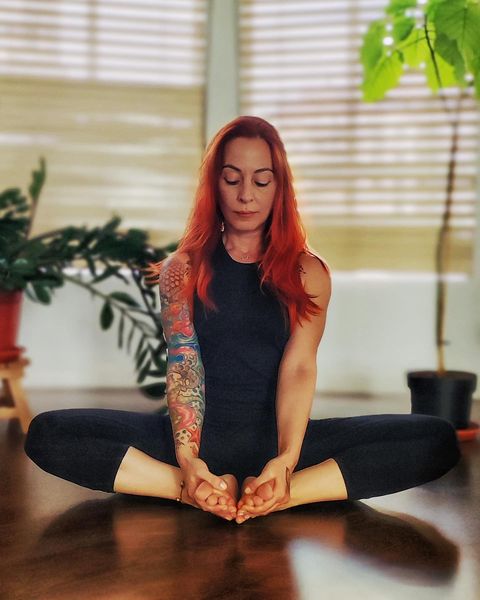
How to:
- Sit with your legs straight in front of you. Exhale and bend the knees, and draw the ankles in toward your pelvis.
- Release the knees outwards and press the soles of the feet together.
- Bring the ankles as close to your pelvis as possible.
- Grasp your big-toe of each foot with the first two fingers and thumb. Try to keep the outer edges of your feet on the floor.
- Sit with your tailbone facing back and the pubis at the same distance from the floor. Lengthen the front torso through the top of your sternum.
- Do not forcefully lower the knees. Instead, drop the head of the thigh-bones toward the floor.
- Stay in this posture for 60 seconds to 5 minutes. While inhaling, lift the knees away from the floor and bring your feet back to the original position.
Benefits
This pose is supposed to open up the hips and groin, which can help relieve anxiety and fatigue. Pregnant women will be interested to know that this yoga pose is claimed to aid in childbirth. The pose also stimulates circulation, the abdomen and lower limbs.
Note: Individuals with a groin or knee injury, practice the pose with support under the outer thighs.
16. Uttanpadasana (Raised leg pose)
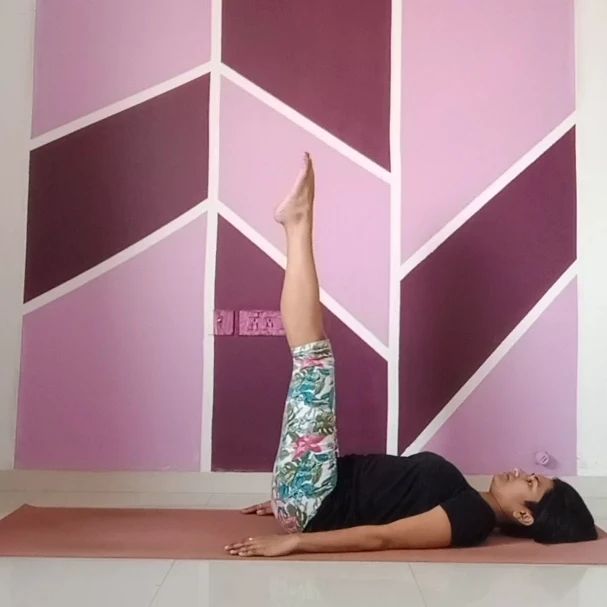
How to:
- Lie on your back on the floor and breathe normally.
- Place your hands on either side and the palms should be facing down.
- Breathe in slowly and lift the feet 45-90 degrees off the floor.
- Hold this pose for 30 to 60 seconds to feel the pressure in your lower abdomen.
- While exhaling, come to the starting position, relax your posture by lowering the legs.
- Repeat this 3-4 more times.
Benefits
The pose improve the functioning of the digestive system and provide relief from indigestion and other stomach-related disorders. It believed to be effective in promoting the health of the heart, lungs, liver, pancreas, and intestines. It works to improve sexual disease and balance hormones.
Note: Avoid this pose if you have low back pain, high BP, people recovering from spinal injuries and during menstruation.
17. Viparita Karani (Legs up the wall pose)
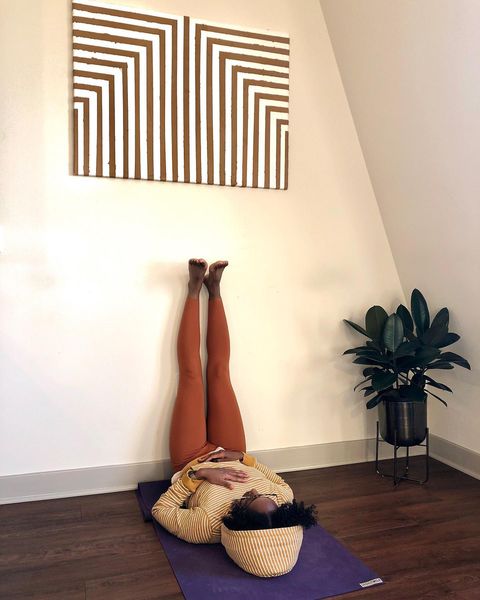
How to:
- Sit on the right side against a wall, bending the knees and pulling the feet in toward the hips.
- To lie on the back, place the feet against the wall.
- Keep the hips against the wall or slightly away.
- Place the arms in any comfortable position.
- Stay in this position for 2-20 minutes.
- To release yourself from the posture, gently push yourself away from the wall.
- Rest on the back for a few moments.
- Draw the knees into the chest and roll to the right side.
- Rest for a few breaths before slowly returning to an upright position.
Benefits
- Research shows that yoga, in general, can have a positive effect on the body’s stress response systems, and restorative yoga poses such as Viparita Karani aim to guide the body into a state of relaxation. 4
- Reducing stress, calming and relaxing has been associated with improved overall physical and mental health, reduced headaches, high blood pressure and even improve infertility and a stronger immune system.
Note: If you have glaucoma, congestive heart failure, uncontrolled high blood pressure, kidney failure, liver failure or cirrhosis, then this pose should not be done at all.
18. Supta Baddha Konasana (Reclining Bound Angle Pose)
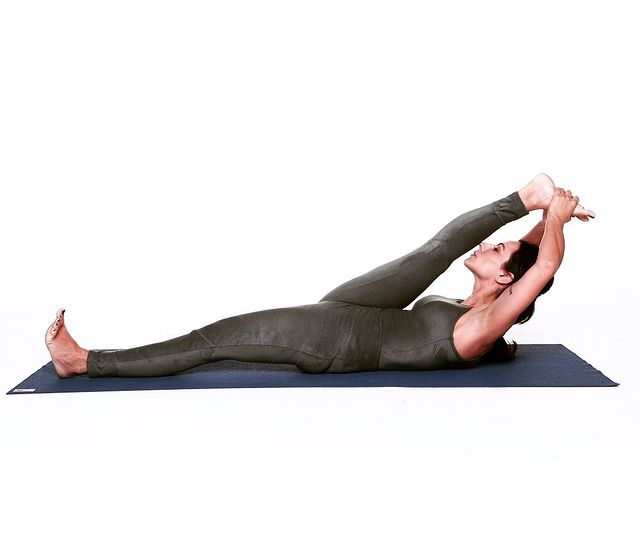
How to:
- Lie on your back, bend your knees and bring the soles of the feet together. Bring your feet to the floor, keeping the ankles close to the hips. Leave the knees wide open.
- Inhale and bring your arms to the floor above your head. Keep your palms together with your thumbs crossed.
- Breathe in and hold for 4-8 breaths.
- To release yourself from the pose, exhale and slowly release your arms and legs.
Benefits
- Helps activate the ovaries and benefits other parts of the body such as the prostate gland, kidneys, and bladder.
- This pose also calms your digestive system and your reproductive system. This pose benefits are not only promoting health but also reducing the symptoms of conditions like menstrual disorders, menopause, infertility, irritable bowel movement etc.
Note: To get the best out of this pose, you should avoid doing this pose in case of any kind of knee injury, back injury, lower back and/or hip pain.
19. External Retention (Bahya pranayama)
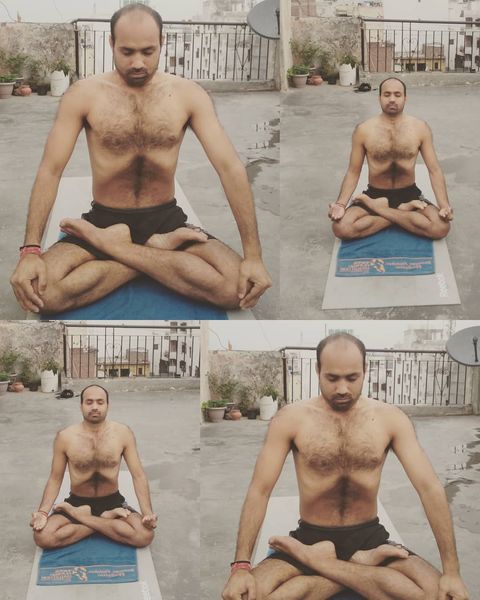
How to:
- In Siddhasana or Padmasana, sitting out methodically, exhale the breath as soon as possible.
- By exhaling the breath, keep the breath as far outside as possible by applying the tricus i.e., the base, the udyan-bandh and the jalandhar-bandh.
- When the desire to breathe changes, then remove the bonds and inhale slowly.
- Breathe in and do the undoing again without stopping it.
- Note – Jalandhar: – Apply the tied chin to the moth. Base: – Draw the anal portion below the navel and the urinals upwards. Finally, Udyan-Bandh: – With the chest slightly up, pull the stomach towards the waist / back.
- In 3 to 5 seconds it is best to fill the breath easily and within 3 to 5 seconds it is best to hold the breath out for 10 to 15 seconds and to do the same activity continuously without stopping again.
- In this way, normally 3 to 5 times the external pranayama becomes comfortable in 2 minutes and 5 times the external pranayama is usually sufficient.
- People suffering from anal fistula, vagina, piles (hemorrhoids), fistula (fistula), and sexual diseases etc. can practice it up to 11 times at a time.
- The seekers wishing to be Kundalini-Jagran and seekers of upliftment can practice this pranayama up to a maximum of 21 times at a time.
- This pranayama is very beneficial in all women-diseases and also-sterility/unresponsive infertility, leucorrhea etc. and uterine defects.
Benefits
- In external pranayama, due to the behavior of high amount of acid (oxygen), the energy consumption is high.5 6
- When the period of extra-kumbhak is longer than the time of supplemental laxative, then the consumption of acid (oxygen) in the body drops by 19 percent.
- Low consumption of oxygen is associated with reduced stress related stress and prolonged survival of all human beings.
- When the period of the external Kumbhak is shorter than the time of supplement or laxative, then the consumption of oxygen in the body increases by 52 percent. Excess consumption of oxygen indicates high energy expenditure and over-stimulation.
- It is beneficial in diseases like piles (hemorrhoids), fistula, anal fistula and vagina. By ejaculating semen, dreaming, premature ejaculation, etc., removes metal disorders.
- Its practice makes the intellect soft and sharp. Protection of Brahmacharya and Kundalini is extremely useful in awakening.
Note: A person suffering from high blood pressure and heart diseases should not practice this pranayama. Headaches, migraine patients also do not practice it. In the beginning, a person should make the body and mind compatible with this practice by not practicing it and practicing other pranayamas. It is a high quality compound practice.
20. Shavasana (Corpse pose)
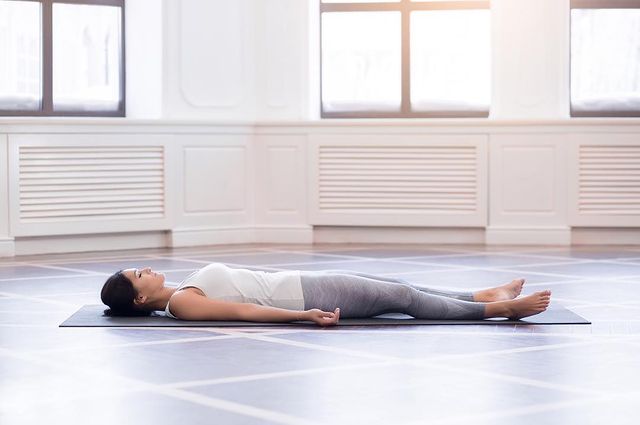
How to:
- Come to lie on the back on the yoga mat. Separate the legs and allow the legs to stick out. Keep the arms a few inches away from the body and turn the palms towards the ceiling.
- Close the eyes and let the body feel heavy, as if it were sinking into the floor. If it’s difficult for you to release, you may find it helpful to do a body scan, starting at the toes and working your way up, releasing each part of the body as you go.
- Breathe naturally, as you generate thoughts, notice them, but don’t get attached to them. Be relaxed but awake.
- Stay in this posture for 5-10 minutes.
Benefits
It brings about a deep, meditative state of relaxation, which can help repair tissues and cells, calms the brain, helps relieve stress and mild depression. It also relaxes the body, reduces headaches, fatigue and insomnia, and helps lower blood pressure.
Note: Avoid this pose in the third trimester of pregnancy.
Bottom line
It has been shown that yoga increase blood flow, improve flexibility and balance, and encourage mindfulness. These health-promoting effects are also thought to have the potential to help naturally improve sexual disease, erectile dysfunction or ED. 7
Erectile dysfunction (ED) affects approximately 52% of people with gender who are between 40 and 70 years old. It is estimated that there will be 322 million cases of Erectile dysfunction (ED) worldwide by the year 2025. 8
There is limited research on yoga and erectile dysfunction, but several small studies suggest that yoga can improve sexual function and satisfaction. In one study, healthy men (ages 28 to 60) who completed 12 weekly yoga sessions reported significant improvements in all measures of sexual function, including desire, orgasm satisfaction, performance, self-confidence, erection, ejaculation control and intercourse is involved.
Other potential benefits of yoga for ED include increased circulation, better focus, better body image, and confidence. 9
- Exploring the therapeutic effects of yoga and its ability to increase quality of life; Catherine Woodyard, Department of Health, Exercise Science and Recreation Management, The University of Mississippi, The Center for Health Behavior Research, 215 Turner Center, University, MS, USA[↩]
- Moseon Lee, Woongjoon Moon, Jaehee Kim, “Effect of Yoga on Pain, Brain-Derived Neurotrophic Factor, and Serotonin in Premenopausal Women with Chronic Low Back Pain”, Evidence-Based Complementary and Alternative Medicine, vol. 2014, Article ID 203173, 7 pages, 2014. https://doi.org/10.1155/2014/203173[↩]
- Front Hum Neurosci. 2018; 12: 353. Published online 2018 Sep 7. DOI: 10.3389/fnhum.2018.00353; PMCID: PMC6137615, PMID: 30245619; How Breath-Control Can Change Your Life: A Systematic Review on Psycho-Physiological Correlates of Slow Breathing.[↩]
- Psychoneuroendocrinology, 2017 Dec;86:152-168. DOI: 10.1016/j.psyneuen.2017.08.008. Epub 2017 Aug 30. Yoga, mindfulness-based stress reduction and stress-related physiological measures: A meta-analysis.[↩]
- Indian Journal of Medical Research, 191; 79 (B): 357-373[↩]
- Effect of fast and slow pranayama on perceived stress and cardiovascular parameters in young health-care students; Int J Yoga. 2013 Jul-Dec; 6(2): 104 110., doi: 10.4103/0973-6131.113400, PMCID: PMC3734635, PMID: 23930028[↩]
- Xiaoming Cui, Jing Zhou, Zongshi Qin, Zhishun Liu, “Acupuncture for Erectile Dysfunction: A Systematic Review”, BioMed Research International, vol. 2016, Article ID 2171923, 6 pages, 2016. https://doi.org/10.1155/2016/2171923[↩]
- ORIGINAL RESEARCH; VOLUME 7, ISSUE 10, P3460-3466, OCTOBER 01, 2010; Yoga in Male Sexual Functioning: A Noncompararive Pilot Study. Vikas Dhikav, MD Girish Karmarkar, MD Myank Verma, MBBS Supriya Gupta, MD Deeksha Mittal, MBBS Kuljeet Anand, MD, DM. DOI: https://doi.org/10.1111/j.1743-6109.2010.01930.x[↩]
- September 8, 2021. Harvard health: Yoga benefits beyond the mat[↩]














